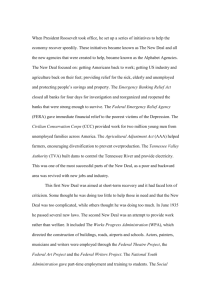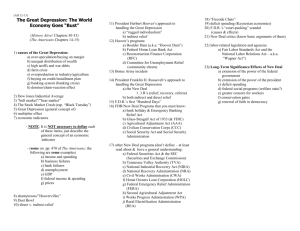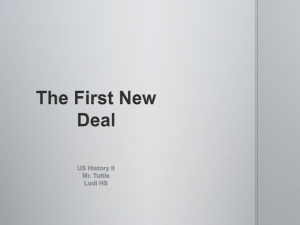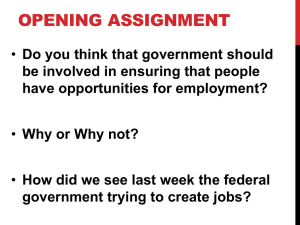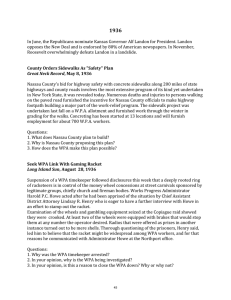Schechter v United States
advertisement
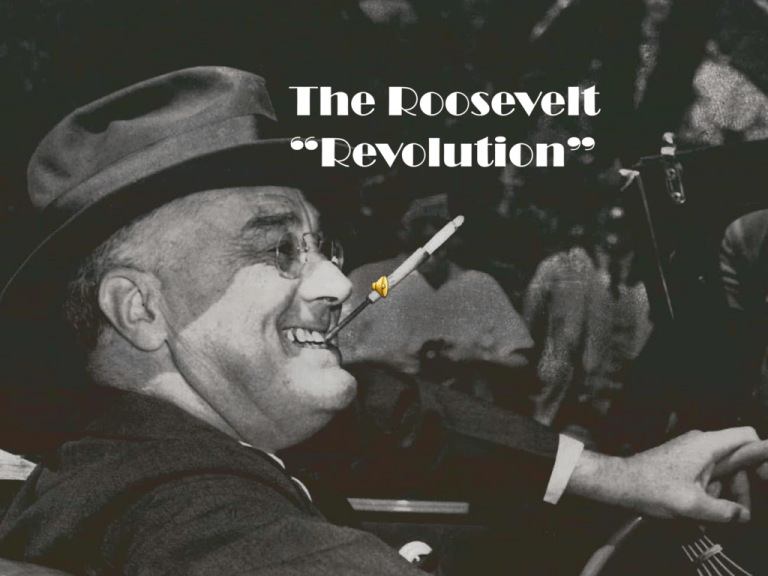
The Roosevelt “Revolution” The Hundred Days, 1933: • • • • Banking and finance Economic Recovery Creating credit Unemployment Relief Banking & Finance • Federal Reconstruction Finance Corporation shored up banks • Separation of commercial and investment banking • Securities and Exchange Commission established • US$ off Gold standard (in 1934 $ pegged at level 60% below 1932 rate) Economic Recovery • Agricultural Adjustment Act created AAA – Raise prices by limiting production • National Industrial Recovery Act created NRA – Voluntary Codes to guarantee prices, wages, employment levels – Exemption from Anti-Trust Legislation – Section 7(a) guaranteeing right to collective bargaining Symbols of the New Deal Creating Credit • Commodity Credit Corporation (under the RFC) • Home Owners’ Loan Corporation (under the RFC) • In 1934: Federal Housing Administration Unemployment Relief • Federal Emergency Relief Administration (FERA) – And creation of state agencies: food stamps, direct relief, work relief • Civil Works Administration (CWA): 2 million federal employees • Works Progress Administration (WPA) • PWA (Harold Ickes) • CCC: Civilian Conservation Corps The CCC Motto: “We Can Take It!” Modernisation • Tennessee Valley Authority (TVA) Limits of AAA and NRA • Production limits evaded (Dust Bowl suppressed agricultural production) • Fate of tenant farmers & sharecroppers • Administrative overload: corruption, disorganisation • Evasion of Section 7(a) • Rising prices a problem as well as a blessing • Economic recovery slow How New? • Continuation of post-Civil War state building? • WW1 War Industries Board • Pluralism, interest groups, bureaucratisation of government • Hoover’s “Associative State”, increasing regulation of economy since 1890s FROM RELIEF TO REFORM… THE STRUCTURAL PROBLEM OF UNEMPLOYMENT IN A CAPITALIST SYSTEM AND THE APPROPRIATE STATE RESPONSE “…equilibrium at less than full employment…” John Maynard Keynes, The General Theory of Unemployment (1936) “We’re in this relief business for a long, long time… Until the time comes, if it ever comes, when industry and business can absorb all able-bodied workers... We shall have with us large numbers of the unemployed. Intelligent people have long since left behind them the notion that…the unemployed will disappear as dramatically as they made their appearance after 1929… For them a security program is the only answer.” Harry Hopkins, Spending to Save (1936), Director of the FERA and later WPA FDR in January 1935 We have not weeded out the overprivileged and we have not effectively lifted up the underprivileged.... Americans must forswear the conception of the acquisition of wealth which, through excessive profits, creates undue private power... In building toward this end we do not destroy ambition, nor do we seek to divide our wealth into equal shares on stated occasions. We continue to recognize the greater ability of some to earn more than others. But we do assert that the ambition of the individual to obtain for him and his a proper security, a reasonable leisure, and a decent living throughout life is an ambition to be preferred to the appetite for great wealth The “Second New Deal” • • • • • Programmes for Economic Recovery The Social Security Act The Wealth Tax Banking and Corporate legislation The Wagner Act (Labor rights) Programmes for Economic Recovery • Works Progress Administration: in total was to employ 8M people, build 100,000 public buildings, 75,000 bridges and 287 airports • Resettlement Administration: address rural poverty, those not helped by AAA • Rural Electrification Administration: expand work of TVA The Social Security Act (1935) • Adopted principle of private life-insurance plan on federal scale • Dealt with “unemployables”: the old, the disabed, families with dependent children; [health in original draft defeated in Congress] • Congress eliminated agricultural and domestic workers; limited federal oversight • Federal-state co-responsibility The “Wealth Tax” • Not as redistributive as supporters hoped • Increased income taxes on richest • Increased corporate taxes and estate taxes • Aimed primarily at increasing government revenue Banking and Corporate legislation • Marked shift from “broker state” to “regulatory state”? • Promoted competition in public utilities, especially power industry The Wagner Act • Committed government to “encourage collective bargaining” • Established National Labor Relations Board • Led to rapid unionisation and to creation of CIO, led by John L. Lewis Elements of the “Second New Deal” • Federal government less concerned with direct relief (FERA abandoned; only tools now WPA and SSA) • Shift from centralised planning to regulation? • Shift from collectivism to class rhetoric? The Supreme Court v The New Deal The Supreme Court: a narrow view of “interstate commerce” Schechter v United States (1935) – NRA unconstitutional Jan 1936: AAA unconstitutional June 1936: A NY state minimum wage law unconstitutional Court-packing plan (1937) Limitations of New Deal • Conservative Aims of New Dealers? – – – – Saving free market capitalism Fiscal orthodoxy (even parsimony?) American nationalism American Ideology? Property rights, federalism, localism, self-help, … and capitalism. – …Pragmatism not conservatism? (so would not take on fights they couldn’t win) • Constraints: – – – – Weakness of “state capacity” Southern Block in Congress… racism Federalism… state governors Residual strength of right – especially wealthy individuals and corporate interests


